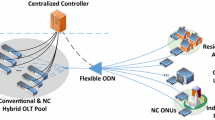Abstract
Ever-increasing demands on bandwidth compel us to improve the bandwidth utilization of access networks. It is more important to enhance the efficiency of passive optical networks (PON) than other access technologies, as they are the primary solutions to various access scenarios. To satisfy the demands of improved bandwidth efficiency, we propose a dual-layer (data link layer and network layer) efficiency enhancement scheme for future PON system. Under this architecture, a data-link-layer flexible coding scheme is introduced to extend the downstream link throughput, and a network-layer centralized active queue management (AQM) scheme is introduced to increase bandwidth efficiency. Both of these technologies are designed to suit the future centralized cooperative control mode. The results of an experimental demonstration of the network coding PON scheme reveal the efficiency of the proposed architecture. The results of simulations show that the centralized AQM scheme has a positive influence on queuing delay and jitter. To the best of our knowledge, this is the first time that a data link layer mechanism and a network layer policy have been integrated to provide high efficiency and quality of service in access networks.
创新点
本文首次针对无源光网络(PON)提出了集中控制下的双层(数据链路层和网络层)效率提升机制。该机制在数据链路层引入了可变光分配网(ODN)的灵活网络编码的同时,在网络层引入了集中式主动队列管理(AQM)切换方案,以增加PON系统下行链路吞吐量、降低网络延迟和抖动。实验测试表明,该系统可提升下行带宽吞吐量近40%,同时增强了排队管理效果的稳定性。所提出方案能够在接入侧实现高效的数据流量压缩和流量疏导,将可用于满足未来接入网集中管控与高效传输需求。
Similar content being viewed by others
References
Ji Y F, Ren D P, Li H, et al. Analysis and experimentation of key technologies in service-oriented optical internet. Sci China Inf Sci, 2011, 54: 215–226
Li J, Shen G. Cost minimization planning for passive optical networks. In: Optical Fiber Communication Conference/ National Fiber Optic Engineers Conference (OFC/NFOEC), San Diego, 2008. 1–3
Liu Y J, Guo L, Zhang L C, et al. A new integrated energy-saving scheme in green Fiber-Wireless (FiWi) access network. Sci China Inf Sci, 2014, 57: 062307
Luo Y, Zhou X, Effenberger F, et al. Time- and wavelength-division multiplexed passive optical network (TWDMPON) for next-generation PON stage 2 (NG-PON2). J Lightwave Technol, 2013, 31: 587–593
Lin B, Li J, Yang H, et al. 100-Gb/s Multi-band OFDM-PON based on polarization interleaving and direct detection. In: Asia Communications and Photonics Conference, Guangzhou, 2012. 1–5
Essiambre R, Kramer G, Winzer P J, et al. Capacity limits of optical fiber networks. J Lightwave Technol, 2010, 28: 662–701
Wei P, Gu R, Ji Y, et al. Dynamic bandwidth allocation algorithm for next-generation time division multiplexing passive optical networks with network coding. Opt Eng, 2013, 52: 379–384
Miller K, Biermann T, Woesner H, et al. Network coding in passive optical networks. In: Proceedings of the IEEE International Symposium on Network Coding (NetCod), Toronto, 2010. 1–6
Adams R. Active queue management: a survey. IEEE Commun Surv Tut, 2013, 15: 1425–1476
Aweya J, Ouellette M, Montuno D Y. A control theoretic approach to active queue management. Comput Netw, 2001, 36: 203–235
Jain S, Kumar A, Mandal S, et al. B4: experience with a globally-deployed software defined WAN. Comput Commun Rev, 2013, 43: 3–14
Cheng N, Effenberger F J. Flexible TWDM PON with Load Balancing and Power Saving. U.S. Patent Application, 14/257 258, 2014-4-21
Li S-Y R, Yeung R W, Cai N. Linear network coding. IEEE Trans Inf Theory, 2003, 49: 371–381
Wei P, Gu R, Ji Y. Network coding based joint signaling and dynamic bandwidth allocation scheme for inter optical network unit communication in passive optical networks. Opt Fiber Technol, 2014, 20: 280–293
Gu R, Ji Y, Wei P, et al. Software defined flexible and efficient passive optical networks for intra-datacenter communications. Opt Switch Netw, 2014, 14: 289–302
Gu R, Zhang L, Ji Y. Secure and efficient metro-access network using network coding. In: 2011 International Conference on Information Photonics and Optical Communications (IPOC), Jurong West, 2011. 1–4
Choi S, Kim T, Lee H. Multiple shared LAN emulation method in EPON based on group ID. U.S. Patent Application 10/934,605, 2004-9-2
Chung J, Claypool M. Analysis of active queue management. In: the 2nd IEEE International Symposium on Network Computing and Applications (NCA), Cambridge, 2003. 359–366
Ge Z, Gu R, Ji Y. An active queue management adaptation framework for software defined optical network. In: 2014 13th International Conference on Optical Communications and Networks (ICOCN), Suzhou, 2014. 1–4
Low S H. A duality model of TCP and queue management algorithms. IEEE ACM Trans Netw, 2002, 11: 525–536
Sun J, Moshe Z. An adaptive neuron AQM for a stable internet. In: Proceedings of the 6th International IFIP-TC6 Conference on Ad Hoc and Sensor Networks, Wireless Networks, Next Generation Internet (NETWORKING), Atlanta, 2007, 4479: 844–854
Author information
Authors and Affiliations
Corresponding author
Rights and permissions
About this article
Cite this article
Ji, Y., Wang, X., Zhang, S. et al. Dual-layer efficiency enhancement for future passive optical network. Sci. China Inf. Sci. 59, 1–13 (2016). https://doi.org/10.1007/s11432-015-5430-7
Received:
Accepted:
Published:
Issue Date:
DOI: https://doi.org/10.1007/s11432-015-5430-7




